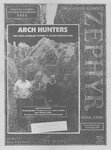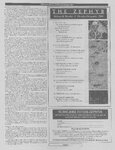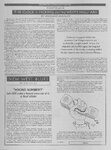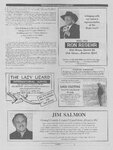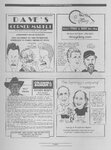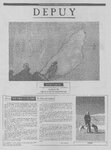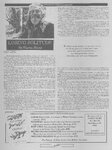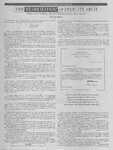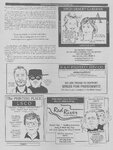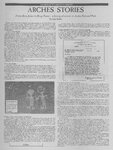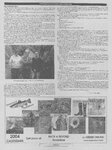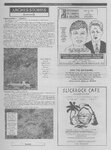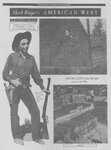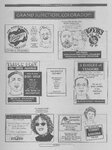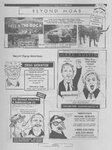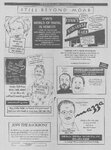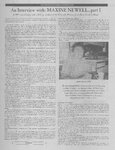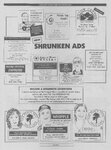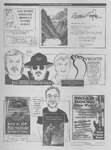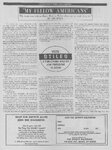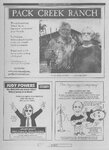| OCR Text |
Show THE ZEPHYR/OCTOBER-NOVEMBER 2004 ARCHES STORIES From Denis Julien to Doug Travers---a history of visitors to Arches National Park By Jim Stiles The National Park Service is in the process of expanding the Arches National Park visitor center, five miles north of Moab. When it was built in the early 1960s, fewer than 75,000 tourists came to the park annually. Four decades later, that number seems almost quaint as visitation pushes toward one million. The park roads are often crowded to the point of gridlock and the trailheads are full. Even on the trails themselves, it’s rare to be out of sight of other hikers. It wasn't always like this. For centuries, for millennia in fact, the stone monuments were unknown, unnamed, and unseen by anyone but the critters that lived there, undisturbed in the shadows of the big rocks. That began to change ‘ever so slightly, about 2000 years ago, when Anasazi indians first wandered into the canyons and mesas and ridges--- to places that would only be assigned “official” names thousands of years later. Their impact on the park came in the form of etched images on the sandstone and the “lithic scatter” of chert left behind by toolmakers of that time. Over the centuries the Anasazi came and left. Utes wandered into the Arches Country in the 17" Century. White men didn’t leave their mark at Arches until the mid-19th Century. And even into the middle of the 20" Century, a relative handful of people found their way to the spectacular arches and windows. If you could tally the total human visitation since the beginning, going back at least 2000 years, 99.9% of them would have arrived since 1958, when the Arches entrance road was paved. Of all the visitors who have come to Arches, some have been memorable enough to still be remembered. A few of the names are well-known—we all know Ed Abbey wrote Desert Solitaire while working as a seasonal ranger at what was then Arches National Monument in the mid-1950s. Bates Wilson was the first superintendent of Arches National Monument and later became known as the “Father of the Canyonlands” for his efforts to preserve the vast canyon country west of Arches. Trivia buffs know that parts of “Thelma and Louise” were shot in the park. But there are other people, more obscure, but just as interesting, whose stories deserve to be heard. Here are a few of them.... I've gone back to the site a few times and am always reminded of one seldom remembered fact-when Julien carved his name, he did it right over the top of an Anasazi petroglyph. He may be the first white man in history to vandalize a prehistoric rock art site. HANK SCHMIDT...THE GREAT ‘REPORT WRITER.’ More than fifteen years before Abbey’s arrival, Hank Schmidt assumed his duties as Custodian at Arches National Monument and began recording his impressions on a typewriter. From 1939 to 1941, Hank Schmidt wrote monthly reports to his superintendent, Frank “Boss” Pinkley in Arizona. Schmidt's folksy conversational reports are still entertaining after all these years. Here are some excerpts... UNITED DEPARTMENT STATES OF THE NATIONAL PARK ANCES eee eee Mr. Hugh MW. Miller, Superintendent Southwestern National Coolidge, Arizona INTERIOR SERVICE NATIONAL #8 MONUMENT |§.| Monuments Dear Hugh: It looks as if the meroury in "Old Trusty” is going to keep right on Imocking at the 100 rari until far into the night (this inspite of the very brief shower that mst have passed up Davy, Jimy eni Zeke to tease-us @ bit), so I might as woll do my sweltering over « typewriter rather than add more steam on the THE NEWLYWEDS... Not much is known of the Native Americans who passed through the Arches Country a thousand years ago. Because the park has a limited number of permanent water sources, many archaeologists believe that the area was used more as a hunting ground than as a place to live. There are few structures in the park (I know of three and I’m not talking). But along many ledges and under shady overhangs, evidence of their presence, in the form of lithic scatter—broken pieces of chert that were discarded as they fashioned projectile points, is common. Ina few remote locations, the Anasazi left their artistic talents on the sandstone. One in particular, always caught my eye. High ona canyon wall, overlooking the modern highway is this image. I would almost swear that one of them is smiling. We used to called them “The Newlyweds.” By Henry G. Schmidt, Custodian Moab, Utah THE FIRST FATALITY AT ARCHES... Freddie Semisch seemed to be cursed with bad luck, from a very early age. He was born in Chicago in 1930 to German-born parents. His mother and father, Anna and Carl, had not yet become naturalized U.S. citizens, however, and in 1939 the Semisch family decided to visit Anna’s mother in their German homeland. They had intended to stay only three months, but when war broke out, the Semisches were prohibited from leaving. They spent the entire war there. In 1946, Freddie, now 16, was allowed to return to the U.S., though his The Archaeological Resource Protection Act prohibits rangers § from disclosing the location of sites like 4 this..so don't even ASK. DENIS JULIEN...JUST PASSING THROUGH For a century, river runners on the Green and Colorado Rivers had seen the bold inscriptions of “D. Julien.” Little was known of Julien but it was assumed he was a fur trapper of French origin and that he had spent time during the 1830s in the Colorado River basin. But no one could ever find a Julien graffiti any later than 1837. There was speculation among historians that Julien’s disappearance suggested he had in fact drowned in the Green River. It was as if he vanished around 1837. Then I came along and screwed up the historical record. One day in the late 1970s, while a seasonal ranger on backcountry patrol at Arches, I spotted some sheepherder inscriptions on a desert varnished wall. Sheepherder graffiti from the 1920s and 1930s is common and I was hoping to find yet another “Domingez” inscription, a frequent visitor to the Arches Country. There, among the 20" Century carvings, another inscription jumped out at me. In a very unique cursive script, the name “Denis Julien” practically jumped off the wall. Beneath it was a date. I could not read the day or month, but I could definitely make out the year—1844. I was aware of the other Julien inscriptions and thought this might be significant. I told the chief ranger the next days and within a week, I was escorting crazed historian John Hoffman, who had flown in from San Diego, to the site. Hoffman recognized its authenticity immediately. “Way to go, Stiles...you just brought Denis Julien back from the dead.” 2 PAGEI4 parents were detained for another six years. Semisch lived in New York where he worked as a watch repair man. In 1950, he planned a cross-country trip with his friend Gilman Ordway. Their destination was California but the long road brought them through Colorado to Utah, to the seldom visited Arches National Monument. On the morning of May 29, 1950, Semisch and Ordway made their way down a rough sandy road to the Devils Garden. They bogged down in the sand at least once; a photographer from California, Stanley Midgeley pulled them out; they arrived at the trailhead at about the same time and all of them hiked north about a mile to Landscape Arch. Semisch, the more reckless of the two, propsosed to Ordway that they climb the arch. To reach Landscape Arch, a hiker needs to go north more than half a mile and ascend the sandstone fin that abuts the arch. This is fairly easy and while the walk along the ridge of the fin is precarious in places, it must have seemed a cake walk for the athletic 20 year old. But the fin runs out, just north of Landscape Arch and from there, you need a good rope or wings—Semisch had neither. But the friction support that the coarse sandstone provides must have convinced Semisch that enough traction was there to inch his way down the abutment to the end of the span. : He was wrong. By now, photographer Midgely had positioned himself and his camera below the arch and could see and hear Semisch, calling from above. Midgely turned to adjust his camera and in the next moment, heard Semisch scream. He looked back to see Freddie sliding down the abutment to the arch, fighting furiously to slow his descent. But the fall was too far and too steep—he hit the narrow shelf at the base of the abutment, his last hope to survive, but could not hold on. He bounced once and went over the side. He fell more than 200 feet. Midgely was the first to reach Semisch’s body. It had rolled another 150 feet after his free fall, into a narrow chute north of the arch. Freddie Semisch was dead upon impact. Ironically, his friend Ordway had walked north from the arch, had not heard Freddie’s screams and did not know of his friend’s death for more than 15 minutes. Other witnesses drove toward park headquarters and encountered park maintenance man Merle Winbourn who informed Superintendent Bates Wilson of the death. Bates arrived a few hours later, with Sheriff J.B. Skewes and two deputies. They recovered the body and hauled Semisch out on horseback to a waiting truck at the trailhead. His parents, still in Germany and unable to leave, could only grieve for their son from the other side of the world. His body was held at a funeral home in Price, Utah until relatives could claim the body. But an uncle and aunt living in the U.S. chose not to. And so on June 5, 1950, a graveside service was held for Freddie Semisch who was buried in an unmarked grave. Ten years later, his parents were able to provide a headstone for his final _ resting place. . |
